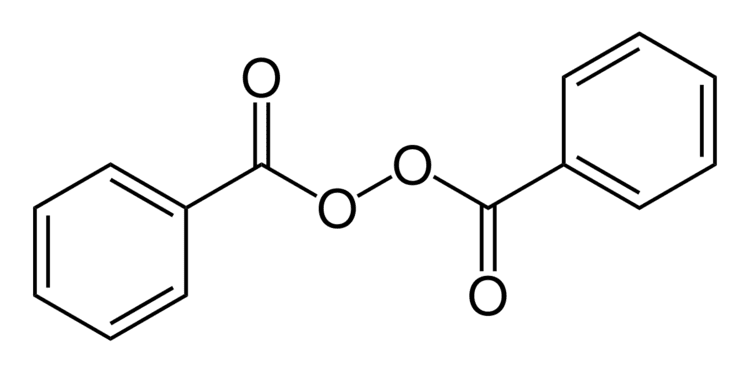CAS Number 94-36-0 | ||
 | ||
AHFS/Drugs.com Multum Consumer Information Pregnancycategory US: C (Risk not ruled out) ATC code D10AE01 (WHO) QD11AX90 (WHO) Synonyms benzoperoxide, dibenzoyl peroxide (DBPO) | ||
Benzoyl peroxide (BPO) is a medication and industrial chemical. As a medication it is used to treat mild to moderate acne. For more severe cases it may be used together with other treatments. Some versions come mixed with antibiotics such as clindamycin. Other uses include bleaching flour, hair bleaching, teeth whitening, and textile bleaching. It is also used in the plastic industry.
Contents
Common side effects are skin irritation, dryness, or peeling. Use in pregnancy is of unclear safety. Benzoyl peroxide is in the peroxide family of chemicals. In acne it works by killing bacteria.
Benzoyl peroxide was first made in 1905 and came into medical use in the 1930s. It is on the World Health Organization's List of Essential Medicines, the most effective and safe medicines needed in a health system. Benzoyl peroxide is avaliable as a generic medication and over the counter. In the United Kingdom 150 ml of a 10% solution costs the NHS about 4.00 pounds. In the United States a month of treatment costs less than 25 USD.
Uses
Most benzoyl peroxide is used as a radical initiator to induce polymerizations. Other major applications include its antiseptic and bleaching properties.
Acne treatment
Benzoyl peroxide is effective for reducing the number and severity of acne lesions. BPO has a bactericidal effect on Propionibacterium acnes bacteria associated with acne and does not induce antibiotic resistance. It may be combined with salicylic acid, sulfur, erythromycin or clindamycin (antibiotics), or adapalene (a synthetic retinoid). Two common combination drugs include benzoyl peroxide/clindamycin and adapalene/benzoyl peroxide, an unusual formulation considering most retinoids are deactivated by peroxides. Combination products such as benzoyl peroxide/clindamycin and benzoyl peroxide/salicylic acid appear to be slightly more effective than benzoyl peroxide alone for the treatment of acne lesions.
Benzoyl peroxide for acne treatment is typically applied to the affected areas in gel, cream, or liquid, in concentrations of 2.5% increasing through 5.0%, and up to 10%. No strong evidence supports the idea that higher concentrations of benzoyl peroxide are more effective than lower concentrations.
Benzoyl peroxide commonly causes initial dryness and sometimes irritation, although the skin develops tolerance after a week or so. A small percentage of people are much more sensitive to it and liable to suffer burning, itching, crusting, and possibly swelling. It is sensible to apply the lowest concentration and build up as appropriate. Once tolerance is achieved, increasing the quantity or concentration and gaining tolerance at a higher level may give better subsequent acne clearance. Irritation can also be reduced by avoiding harsh facial cleansers and wearing sunscreen prior to sun exposure.
Other uses
Other common uses for benzoyl peroxide include
In the U.S., the typical concentration for benzoyl peroxide is 2.5% to 10% for both prescription and over-the-counter drug preparations that are used in treatment for acne. Higher concentrations are used for hair bleach and teeth whitening. Benzoyl peroxide, like most peroxides, is a powerful bleaching agent. Contact with fabrics or hair can cause permanent color dampening almost immediately. Even secondary contact can cause bleaching; for example, contact with a towel that has been used to wash off benzoyl peroxide-containing hygiene products.
Side effects
Concentrated benzoyl peroxide is potentially explosive like other organic peroxides, and can cause fires without external ignition. The hazard is acute for the pure material, so the compound is generally used as a solution or a paste. For example, cosmetics contain only a small percent of benzoyl peroxide and pose no explosion risk.
The carcinogenic potential of benzoyl peroxide has been investigated. A 1981 study published in the journal Science found that although benzoyl peroxide is not a carcinogen, it does promote cell growth when applied to an initiated tumor. The study concluded, "caution should be recommended in the use of this and other free radical-generating compounds".
In a 1977 study using a human maximization test, 76% of subjects acquired a contact sensitization to benzoyl peroxide. Formulations of 5% and 10% were used.
The U.S. National Institute for Occupational Safety and Health has developed criteria for a recommended standard for occupational exposure to benzoyl peroxide.
Chemistry
It consists of two benzoyl groups bridged by a peroxide link. Its structural formula is (C6H5CO)2O2. It is one of the most important organic peroxides in terms of applications and the scale of its production.
Benzoyl peroxide was the first organic peroxide prepared by intentional synthesis. It was prepared by treating benzoyl chloride with barium peroxide, a reaction that probably follows this equation:
2 C6H5C(O)Cl + BaO2 → (C6H5CO)2O2 + BaCl2Benzoyl peroxide is usually prepared by treating hydrogen peroxide with benzoyl chloride.
2 C6H5COCl + H2O2 + 2 NaOH → (C6H5CO)2O2 + 2 NaCl + 2 H2OThe oxygen–oxygen bond in peroxides is weak. Thus benzoyl peroxide readily undergoes homolysis (symmetrical fission), forming free radicals:
(C6H5CO)2O2 → 2 C6H
5CO•
2
The symbol • indicates that the products are radicals; i.e., they contain at least one unpaired electron. Such species are highly reactive. The homolysis is usually induced by heating. The half-life of benzoyl peroxide is one hour at 92 °C. At 131 °C, the half-life is one minute.
Benzoyl peroxide breaks down in contact with skin, producing benzoic acid and oxygen, neither of which is very toxic.
